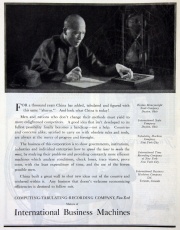Computing-Tabulating-Recording Co: Difference between revisions
No edit summary |
No edit summary |
||
| Line 7: | Line 7: | ||
1896 Hollerith formed a small business in the United States to manufacture and market his machines. | 1896 Hollerith formed a small business in the United States to manufacture and market his machines. | ||
1902 '''Tabulating Machine Company''' (or TMC) owned the rights to Hollerith's machines<ref>The Staffordshire University Computing Futures Museum Computers Page [http://www.fcet.staffs.ac.uk/jdw1/sucfm/sucfmcomputers.htm | 1902 '''Tabulating Machine Company''' (or TMC) owned the rights to Hollerith's machines<ref>The Staffordshire University Computing Futures Museum Computers Page [http://web.archive.org/web/20120711160111/http://www.fcet.staffs.ac.uk:80/jdw1/sucfm/sucfmcomputers.htm]</ref>. | ||
1908 The '''Tabulating Machine Company''' (TMC) gave an exclusive license to the [[British Tabulating Machine Co]] of London to market its punched-card machines in Britain and the Empire. | 1908 The '''Tabulating Machine Company''' (TMC) gave an exclusive license to the [[British Tabulating Machine Co]] of London to market its punched-card machines in Britain and the Empire. | ||
Revision as of 08:27, 21 April 2018

Later International Business Machines (IBM).
1880s Herman Hollerith invented the punched-card technology for use in the US census[1].
1896 Hollerith formed a small business in the United States to manufacture and market his machines.
1902 Tabulating Machine Company (or TMC) owned the rights to Hollerith's machines[2].
1908 The Tabulating Machine Company (TMC) gave an exclusive license to the British Tabulating Machine Co of London to market its punched-card machines in Britain and the Empire.
1911 TMC became part of the Computing-Tabulating-Recording Co (C-T-R).
1924 C-T-R was renamed International Business Machines - IBM.

